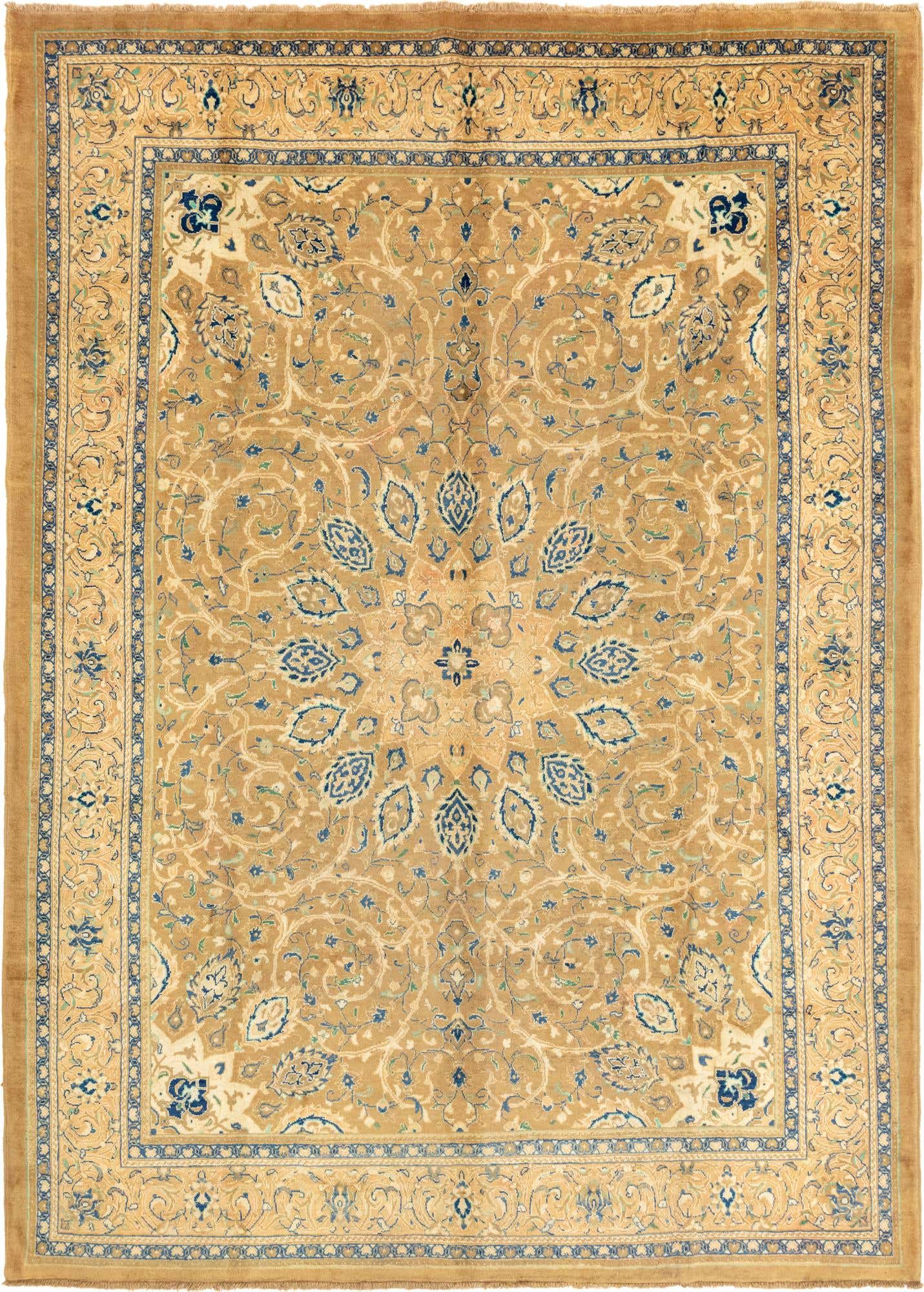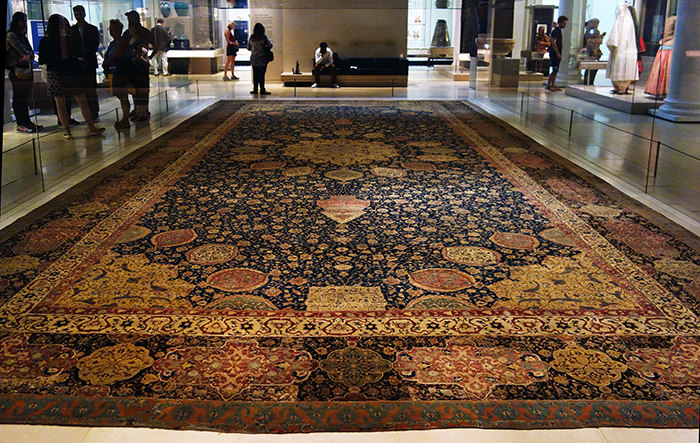A rug is considered tribal if it is produced by a nomadic tribe of people who move from place to place, generally according to the seasons, in order to find shelter and sustenance. Sometimes nomads move in the search of greener pastures for their sheep; other times they move with seasonal work. Their lifestyle, journeys and the landscapes they encounter have great influence on the weavers who make these rugs, most often out of necessity. The material, colors, and design of their creations reflect their needs, dreams and desires as constrained by time and the availability of material and dyes. As such tribal rugs, more than any other type of rug, are inextricably intertwined with the humanity of their creators.
Tribal rugs draw you into the uniquely intimate world of a global culture that survives and seemingly lives within the weave, knots, and design. Outwardly simple symbols that have ancient meaning are passed down for generations woven into the rustic design. The tribes that make these unique rugs put their people, rituals, beliefs, and secrets into these rugs. Berber, Turk, Azeri, Bakhtiari, Kurd, and Qashqai, are just a few of the countless tribes around the world that produce bold rugs that are practical and meaningful to their people. It is a privilege to have an opportunity to actually own one of these rugs and bring a part of the world into your home.
Tribal Moroccan Berber
Quite possibly the most iconic and recognizable tribal rug is the Moroccan Berber. It is ubiquitous in New York City design show rooms and in homes from California to Kansas, and for good reason. Moroccan rugs fit wonderfully into the decade long interior trend of minimalism. They can add unique character to sparse rooms by virtue of their traditional charm. Their minimal abstract design is what attracts western admirers, but in their country of origin these rugs are a way of life. They are used for floor coverings as well as blankets in the coldest regions of the Atlas Mountains.
Almost all Moroccan rugs are handmade from start to finish. From shearing the wool, to washing and dying the wool, to weaving the rugs knot by knot, every step of the process is carried out manually. The techniques have evolved over the years, but derive from ancient knotting and weaving methods passed down over centuries from weaver to weaver.
From the vintage Berber carpets knotted by hand in the Atlas Mountains, to the flat weave tribal rugs, Beni Ourain, Azilal, and Boucherouite rugs, they are all as unique as the country and people.

Bakhtiari Tribal Rugs
As one might expect, many of the sought after tribal rugs are woven in Iran. The most recognizable of these is probably the Bakhtiari rug. Tribal rugs hand knotted by the Bakhtiari tribe come in a variety of designs, the most recognizable being the Garden Panel. The design of this rug consists of rows and columns of squares (occasionally diamonds, hexagons, or other repeated shapes). Within the squares one will find plants, animals, and all manner of inspiration from the natural world.
Bakhtiari rugs tend to be very rich in color, skewing toward deep and dark reds and browns, but with bright touches of green, yellow, and ivory. They are constructed of sturdy wool and usually employ the symmetrical and sturdy Turkish knot. Their beauty and durability is a testament to the artistic sensibilities yet resilience of the Bakhtiar tribe.

Balouchi Rugs
Balouchi rugs are woven by tribes that roam and occupy eastern Iran and the western borders Afghanistan and Pakistan. The distinct repeated lozenge, and often used dominant blood red background color is the best way to spot a Balouchi rug. Balouchi weavers also use a lot of navy, black, dark brown, and ivory. Using wool and cotton, nomads from this region can take up to 10 months to hand knot one of these rugs. They tend to be smaller in size and are often made specifically for use as prayer rugs. That is why the second most common design in Balouchi rugs is the mehrab, which resembles an archway typically found in a mosque. The density of these rugs range from 90-200 knots per square inch.

Gabbeh Rugs
The Persian Gabbeh is a close cousin to the Moroccan Berber when it comes to popularity and use in contemporary interiors. Like the Moroccan, it generally consists of a very simple mostly solid color background and small design elements that resemble children’s drawings. They are so different from traditional Persian rugs. If you spot a Persian rug with a thick pile, a solid background, and brightly colored elemental designs such as stick figures, you’ve likely found a Gabbeh. One of the differences between a Gabbeh and a Moroccan is that the Persian rug has a much tighter weave and a more “groomed” look to the pile.
But don’t be fooled by the simplistic designs of the Gabbeh. The brightly colored small patterns in reds, oranges, maroons, and bright yellows are symbolic to the people who weave these captivating rugs. The romance of these rugs was expressed and immortalized on film by one of Iran’s most important filmmakers Mohsen Makhmalbaf. The film, entitled Gabbeh, was a favorite at the Cannes Film Festival and is a must see for anyone who is interested or owns a Gabbeh carpet.

Nomadic Qashqai (or Ghashqai) Tribal Rugs
Qashqai Persian tribal rugs were originally crafted by the nomadic tribe of the same name. The Qashqai people are Turkic and are believe to have arrived to the area in and around Shiraz in the 11th and 12th centuries. Originally nomadic pastoralists who traveled with their herds, they were encouraged to settle in the mid-20th century when the Iranian government built housing for them. They are well known for the beautifully crafted Qashqai rugs, which are woven with unusually soft wool that holds dye remarkably well. Qashqai rugs, sometimes labeled Shiraz because they are sold in the Shiraz marketplace, have brilliant blues and reds. Their designs have evolved from family traditions and tribal history.

Turkish Tribal Rugs
In Turkey, carpet weaving is thought to have been integrated into tribal life sometime in the 11th century. The Seljuk tribes located in what is today a portion of Kazakhtstan are the first Turkish nomads known to learn the art of rug making. Turkish tribes used carpet weaving techniques to make tents, floor coverings, and blankets to protect them in harsh cold winters.
As in Iran, many of the traditionally nomadic tribes eventually adopted a sedentary lifestyle, but continue to weave rugs with the techniques and designs used by their ancestors. Turkish tribal rugs tend to look more primitive and are less sturdy and symmetrical than their Persian counterparts. The imperfections are part of their appeal. They sometimes use unusual materials like goat or camel hair in the pile. And because the natural dyes used are created in small batches, shade variations occur within the same color woven into one rug. This results in what is termed abrash. For example, a turquoise background can be lighter on one end of the carpet and gradually (or not-so-gradually) grow darker towards the opposite end of the rug.

Home Decor with Tribal Rugs
The tribal rug trend in home décor has endured since the mid-20th century when travelers began bringing exotic lands they visited home in the form of floor coverings. A tribal rug has the power to bring meaning and sophistication to interiors. These unique carpets can bring a sense of exploration and artistry to an otherwise neutral space.
The global cultures they represent can add an exotic warmth to minimalist spaces that seem to be the norm everywhere. Homeowners and designers can easily make an ordinary space extraordinary with imperfect pieces from Morocco, Iran, Afghanistan, and Turkey. Often woven with handspun wool and vegetable dyes, they are not only versatile but durable.











